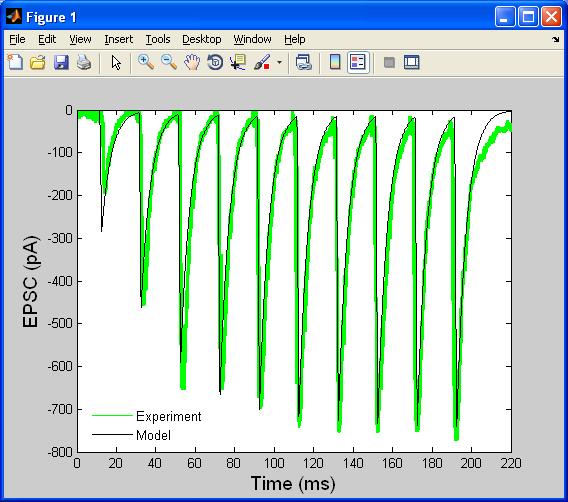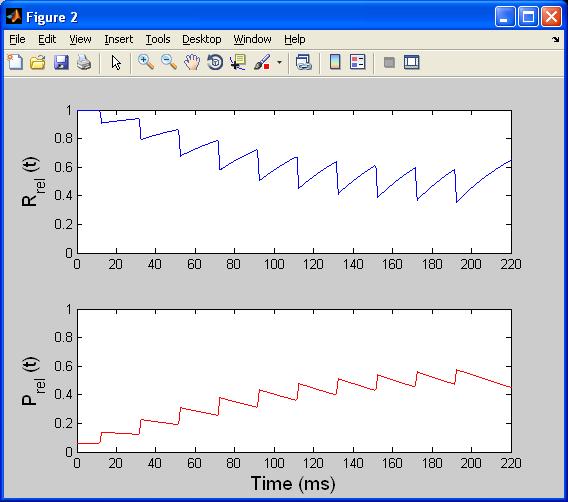This file folder contains the supplemental codes for the manuscript:
Lee, C.-C., Anton, M., Poon, C.-S., and McRae G. J. (2009) The Unified
Theory of Homosynaptic Short Term Depression and Facilitation,
J. Comput. Neurosci. 26(3):459-473.
Files in the main directory are either the .m for standard Matlab
codes or .sml of Simulink Model files. In addition, "Input" folder
includes the experimental transient responses of synapses under
faciliation and mixture effects; "Output" folder contains the
simulation results output by Simulink files. Here is the list
describing the contents of individual .m and .sml files. The first
points below contain examples of how the matlab code corresponds to
the paper figures.
1. Analytical_freq_sim.mdl and Analytical_freq.m: This file set
calculates the transient response of presynapses by both simulation
and average approximation. Running analytic_freq from the matlab
command line reproduces figures 2a,b:

 2. Facilitation.mdl, facilitation_freq.m, facilitation_presyn.m,
facilitation_temp.m: This file set generates the transient and
frequency EPSC responses of facilitating synapses. The Probability of
release and Ratio of realeasable vehsicle resposes are also output.
Running facilitation_freq generates figure 3a,b:
2. Facilitation.mdl, facilitation_freq.m, facilitation_presyn.m,
facilitation_temp.m: This file set generates the transient and
frequency EPSC responses of facilitating synapses. The Probability of
release and Ratio of realeasable vehsicle resposes are also output.
Running facilitation_freq generates figure 3a,b:

 and facilitation_temp generates figures 3c,d:
and facilitation_temp generates figures 3c,d:

 3. Depression.mdl, depression_freq.m, depression_presyn.m,
depression_temp.m: This file set generates the transient and frequency
EPSC responses of depressing synapses. The Probability of release and
Ratio of realeasable vehsicle resposes are also output.
4. Mixture.mdl, mixture_freq.m, mixture_presyn.m, mixture_temp.m:
This file set generates the transient and frequency EPSP responses of
facilitating synapses. The Probability of release and Ratio of
realeasable vehsicle resposes are also output.
5. resonance_freq_2D.m and resonance_freq_3D.m: These two files
calculate the resonance frequency response of synapses with different
parameters and plots its 2D and 3D responses, respectively. In
addition, resonance_freq_3D.m generates the perturbation surfaces,
resonance frequency, and the bandwidth of frequency response.
3. Depression.mdl, depression_freq.m, depression_presyn.m,
depression_temp.m: This file set generates the transient and frequency
EPSC responses of depressing synapses. The Probability of release and
Ratio of realeasable vehsicle resposes are also output.
4. Mixture.mdl, mixture_freq.m, mixture_presyn.m, mixture_temp.m:
This file set generates the transient and frequency EPSP responses of
facilitating synapses. The Probability of release and Ratio of
realeasable vehsicle resposes are also output.
5. resonance_freq_2D.m and resonance_freq_3D.m: These two files
calculate the resonance frequency response of synapses with different
parameters and plots its 2D and 3D responses, respectively. In
addition, resonance_freq_3D.m generates the perturbation surfaces,
resonance frequency, and the bandwidth of frequency response.

 2. Facilitation.mdl, facilitation_freq.m, facilitation_presyn.m,
facilitation_temp.m: This file set generates the transient and
frequency EPSC responses of facilitating synapses. The Probability of
release and Ratio of realeasable vehsicle resposes are also output.
Running facilitation_freq generates figure 3a,b:
2. Facilitation.mdl, facilitation_freq.m, facilitation_presyn.m,
facilitation_temp.m: This file set generates the transient and
frequency EPSC responses of facilitating synapses. The Probability of
release and Ratio of realeasable vehsicle resposes are also output.
Running facilitation_freq generates figure 3a,b:

 and facilitation_temp generates figures 3c,d:
and facilitation_temp generates figures 3c,d:

 3. Depression.mdl, depression_freq.m, depression_presyn.m,
depression_temp.m: This file set generates the transient and frequency
EPSC responses of depressing synapses. The Probability of release and
Ratio of realeasable vehsicle resposes are also output.
4. Mixture.mdl, mixture_freq.m, mixture_presyn.m, mixture_temp.m:
This file set generates the transient and frequency EPSP responses of
facilitating synapses. The Probability of release and Ratio of
realeasable vehsicle resposes are also output.
5. resonance_freq_2D.m and resonance_freq_3D.m: These two files
calculate the resonance frequency response of synapses with different
parameters and plots its 2D and 3D responses, respectively. In
addition, resonance_freq_3D.m generates the perturbation surfaces,
resonance frequency, and the bandwidth of frequency response.
3. Depression.mdl, depression_freq.m, depression_presyn.m,
depression_temp.m: This file set generates the transient and frequency
EPSC responses of depressing synapses. The Probability of release and
Ratio of realeasable vehsicle resposes are also output.
4. Mixture.mdl, mixture_freq.m, mixture_presyn.m, mixture_temp.m:
This file set generates the transient and frequency EPSP responses of
facilitating synapses. The Probability of release and Ratio of
realeasable vehsicle resposes are also output.
5. resonance_freq_2D.m and resonance_freq_3D.m: These two files
calculate the resonance frequency response of synapses with different
parameters and plots its 2D and 3D responses, respectively. In
addition, resonance_freq_3D.m generates the perturbation surfaces,
resonance frequency, and the bandwidth of frequency response.